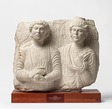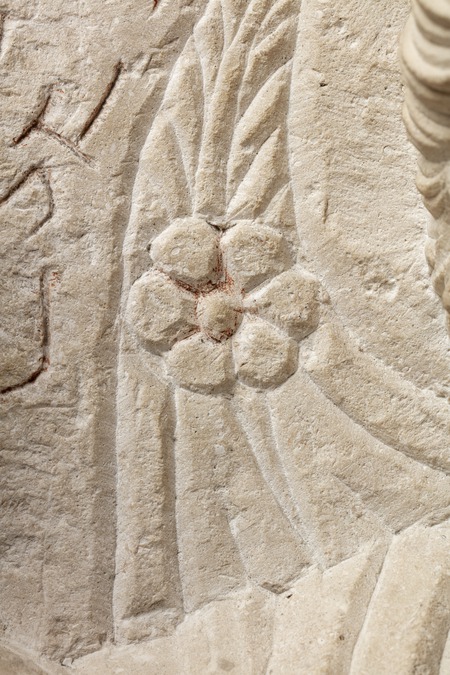Palmyrene loculus relief depicting a man and a woman
Summary
A man and a woman are depicted side by side on a grave relief. Small fragments are missing from the edge of the object. A falsified inscription with traces of a dark pigment is placed in between the heads of the two individuals portrayed. Both portraits are well-preserved: only a crack is visible on the right forearm of the male portrait, while a piece beneath the woman’s left elbow is missing.
The man is portrayed wearing the so-called ‘Parthian style’ attire. He is holding a rounded object in his hands. The woman is wearing a tunic and her veil/himation is wrapped around her chest and shoulders. Behind her, on the background, a cloth is visible.
Description of object
This relief is rectangular with a male and female, both unidentified, situated next to one another. All sides of the object are chipped, and the lower left corner is broken off. There are traces of red pigment in the inscriptions and rosettes. There are tooth-chisel marks on the surface of the background and chisel and rasp marks on the figures. The lower parts of the eyes and the lower eyelids of both figures are not carved. There is minor damage to both of the figures; Portrait A: the upper part of the head is broken off, with a large crack running through the right arm. The locks along the shoulders are carved into the lower relief. Portrait B: the left elbow is chipped.
The man is portrayed frontally. His hair is short and is indicated by horizontal rows with vertical strands of hair. Furthermore, two long locks of hair are visible just above the shoulders of the man, stemming from his neck. His forehead is flattened and the eyebrows are indicated by wide, curving ridges. The eyes are large and almond-shaped, however, left blank. The nose is wide, and the ears are protruding with indication of helix. His mouth is full, with the upper lip indicated in the shape of a cupid’s bow. The chin is protruding with a small depression in the middle. Three grooves are indicated on his neck. The man is wearing a long-sleeved tunic in the so-called ’Parthian style’. The heavy folds running down the sleeves are indicated by semi-circular ridges. The rounded neckline is decorated with a beaded border. Another beaded band is placed just above his left chest in the shape of a reverse L. A band is running vertically down the central part of the tunic and the band is decorated with encircled rosettes. The cuff of the sleeves are decorated with diamond shapes created by narrow grooves. His arms are under proportioned and held horizontally in front of the torso. The right hand is resting on the object held in his left hand. The object is rounded with a Y-shaped incision. All fingers are slightly flexed and fingernails are indicated.
The body of the woman is turned slightly towards her right side, towards the man. She is portrayed with a cloth hanging behind her in the background. The cloth is pinned by two rosettes with leaves projecting upwards. She has piled-up hair and slightly waved hair is visible on both sides of her head, covering her ears. The locks are indicated by horizontal ridges. The coiffure raises upwards in wide, twisted locks, and on the top of her head, a thick, twisted lock is positioned, almost resembling a small crown. Her forehead is flattened and the eyebrows are indicated by wide, curving ridges. The eyes are large and almond-shaped, however, left blank. The nose is narrow and her mouth is full with the upper lip indicated in the shape of a cupid’s bow. Three grooves are indicated on her neck. The woman is wearing a short-sleeved tunic with a rounded neckline. A himation is worn, covering parts of the torso. A large fold emerges from the right shoulder and runs across the chest, above the left shoulder, around the left wrist and into the hand of the woman. The arms are under proportioned. Her right arm is extended, embracing the man portrayed beside her. The hand with all fingers extended, is resting on the right shoulder of the man. She is holding her left arm in front and into her chest. She is wearing earrings consisting of two beads attached vertically to one another. Moreover, she is wearing a plain necklace close to her neck.
There is an inscription situated in between the middle of the statues, but the authenticity has been disputed. Inscribed at head height, the inscription cannot be translated, but some of the letters might be Nabataean (Hvidberg-Hansen and Ploug, 1993.) The more likely case, however, is that it was a later addition to the statue at the time of its sale, presumably to add “value” when it was sold.
H: 45.5 cm.; W: 53 cm.; D: 19.5 cm. Portrait A: Figure, H: 43 cm.; W: 28.5 cm.; D: 9.5 cm. Head, H: 12 cm.; W: 13 cm.; D: 9.5 cm.
Portrait B: Figure, H: 43.5 cm.; W: 23.5 cm.; D: 10 cm. Head, H: 15.5 cm.; W: 13 cm.; D: 10 cm.
Choice of methods
Visual examination
- Macroscopic
Bibliography
H. Ingholt (1928), Studier over Palmyrensk Skulptur, København, 143, PS 452.
H. Ingholt (1935), Five Dated Tombs from Palmyra, Berytus II, 80, pl. XXXVII,2
M.A.R. Colledge (1976), The Art of Palmyra, London, 62, 68, 71, 124, 139, 143, 145, 149, 151, 157, 249, 251, 254, 263, pl. 94.
K. Parlasca (1987), Ein antoninischer Frauenkopf aus Palmyra, in Frel, J. et. al. (eds.) Ancient portraits in the J. Paul Getty Museum, Volume 1, Malibu, 111-112, abb. 4.
F.O. Hvidberg-Hansen & G. Ploug (1993), Palmyra Samlingen, Ny Carlsberg Glyptotek, København, 130-131, no. 85.
G. Ploug (1995), Catalogue of Palmyrene Sculptures, Ny Carlsberg Glyptotek, Copenhagen, 208-210, no. 85.
F.O. Hvidberg-Hansen (1998), The Palmyrene Inscriptions. Ny Carlsberg Glyptotek, Copenhagen, 75-76, no. 85.
M. Heyn (2010), Gesture and Identity in the Funerary Art of Palmyra, American Journal of Archaeology 114/4, app. 3, cat. 15a-15b.
S. Krag (2016), Females in group portraits in Palmyra, in A. Kropp & R. Raja (eds.), The World of Palmyra, Palmyrene Studies 1, Copenhagen, 182, fig. 1.
R. Raja (2016), Representations of Priests in Palmyra: Methodological Considerations on the Meaning of the Representation of Priesthood in the Funerary Sculpture from Roman Period Palmyra, in R. Feldmeier, K.L. King, R. Raja, A.Y. Reed, C. Riedweg, J. Rüpke, S. Schwartz, C. Smith, M. Vinzent (eds.), Religion in the Roman Empire, Tübingen, 139-137, fig. 3.
S. Krag, (2018), Funerary Representations of Palmyrene Women. From the First Century BC to the Third Century AD, Studies in Classical Archaeology 3, Turnhout, 58, 71, 73, 75, 371, cat. no. 773.
- IN 1153
- Portrait relief
- c. 230-250 C.E.
- Roman Imperial
- Limestone
- Acquired by Puttmann in Syria. Original grave context unknown.
- H: 45.5 cm.; W: 53 cm.; D: 19.5 cm. Portrait A: Figure, H: 43 cm.; W: 28.5 cm.; D: 9.5 cm. Head, H: 12 cm.; W: 13 cm.; D: 9.5 cm. Portrait B: Figure, H: 43.5 cm.; W: 23.5 cm.; D: 10 cm. Head, H: 15.5 cm.; W: 13 cm.; D: 10 cm.





